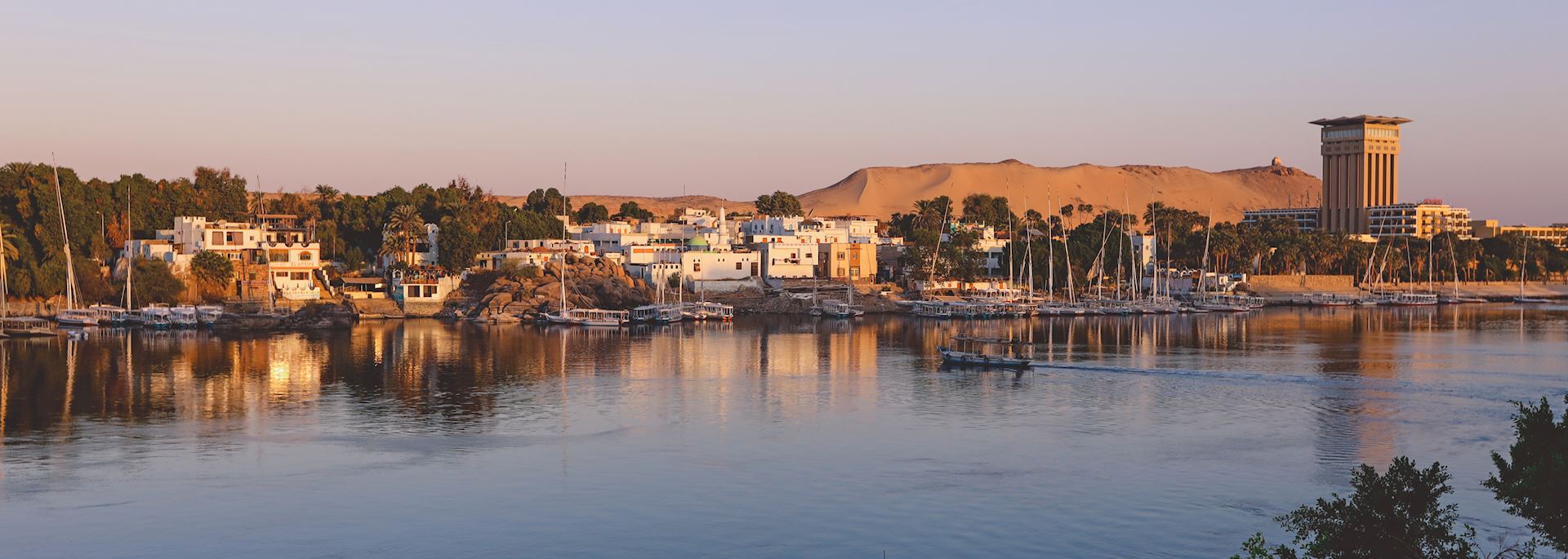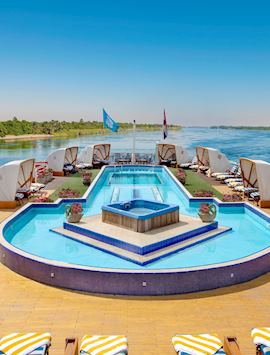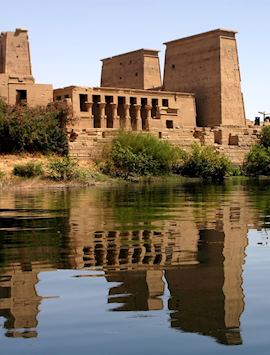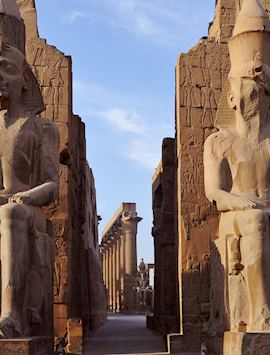By Egypt specialist Anastasia
Historically the easiest way to travel through Egypt, Nile river cruises have been carrying visitors between Luxor and Aswan for well over a century. Winding along the river at a relaxed pace, you see the country through the eyes of early visitors who came to marvel at the tombs and temples left behind by the ancient Egyptians.
Walking through the darkened corridors of a tomb, its walls covered in hieroglyphics and paintings of ancient gods, my imagination runs wild. Huge columns still stand at ruined temples, while scorched ceilings are evidence of sacrilege by early Christians. This is a journey not just through land and water, but through thousands of years of history, culture, religion, and architecture.
My recommended Nile cruise route: Luxor to Aswan

Beginning in Luxor and ending in Aswan, my recommended route lasts five days and four nights. This gives you a good amount of time to both see the sites and spend a while relaxing on board.
The first night is spent at Luxor itself, the second at Edfu, and the third and fourth at Aswan. Along the way, you visit Luxor and Karnak Temples, several tombs at the Valley of the Kings, the Temple of Edfu, the Temple of Kom Ombo, and Philae Temple. You may also have a chance to spend time exploring Aswan’s markets, Nubian Museum, and High Dam.
Sailing the route in reverse takes a day less because you’re following the direction of the river. There’s also the option to embark on a seven-night round trip to see the highlights at a more leisurely pace on a traditional dahabiya (sailing boat).
A typical day on a Nile river cruise
Each morning, you’ll wake up early to visit temples or tombs while it’s cooler, usually in a small group with an expert guide. Whichever vessel or route you’ve chosen, you’ll stop at each of the main sites, gathering knowledge about the region’s rich history as you go. On my own cruise, I found it interesting to learn that the ancient Egyptians generally built temples along the Nile’s east bank and tombs along the west, reflecting their worship of the sun.
After your morning tour, you return to your vessel for lunch. The afternoon is either spent visiting another monument or enjoying the timeless sights and sounds of the river as you relax on board. I loved sitting on the open deck with a drink, watching fishermen drift past on their feluccas (traditional wooden sailing boats). The scenery varies from the hubbub of towns to quiet villages, distant sand dunes, and fertile green fields, and the gentle pace of a cruise allows you to really soak up the shifting views.
Highlights of a Nile cruise
As you sail along the Nile, you’ll stop off to visit various tombs, temples, and monuments that date back hundreds or thousands of years. Each one gives you a glimpse into the lives, cultures, and beliefs of ancient Egyptians.
Luxor and Karnak Temples
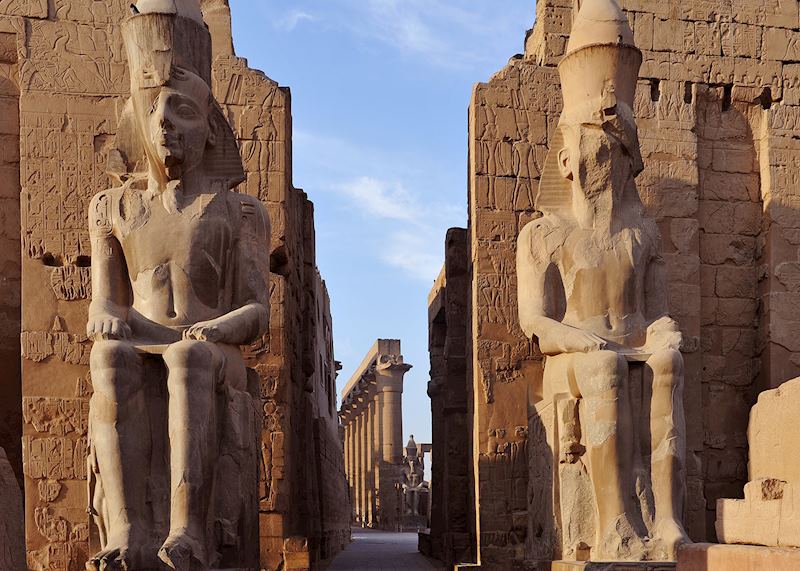

The town of Luxor lies on the site of Thebes, the capital of ancient Egypt, and has the highest concentration of temples and tombs in the world. Here you’ll visit the huge Karnak Temple complex, which was constructed and expanded over the course of centuries from around 1,971 BCE. You’ll also explore the smaller Luxor Temple, built in around 1,400 BCE, and the avenue of sphinxes that connects the two.
Around 30 different pharaohs added to Karnak Temple over the years. As you wander around, your guide will point out the diversity of building styles and explain the various representations of gods that the ancient Egyptians worshipped at different times.
What struck me was the size and scale of the complex — it’s the second-largest ancient religious site in the world after Cambodia’s Angkor Wat. You could spend hour upon hour exploring its halls, pillars, and stone statues. I was most impressed by the Great Hypostyle Hall, which contains 134 columns rising up 24 m (80 ft).
Luxor Temple is right in the heart of the town, its ancient columns contrasting with modern roads and buildings. The temple was dedicated to the god Amun, his wife Mut, and their son Khonsu — the moon god.
When you arrive, you’re greeted by two great seated statues of Ramesses II, and throughout the complex you can admire intricately detailed hieroglyphics painted on the walls and columns. Your guide will help to decipher them and explain their significance as you wander.
You can also return to Luxor Temple in the evening, when it’s at its most atmospheric, lit up against the night sky.
Valley of the Kings

Across the river from Luxor on the Nile’s West Bank, the Valley of the Kings was used as a pharaoh burial site for over 500 years and is home to at least 63 known tombs, each containing up to 150 chambers. Among them are the tombs of Tutankhamun, Hatshepsut, the second female pharaoh, and both Ramesses II and III, and it’s believed more tombs are awaiting discovery.
They’re opened up to visitors on a rotational basis to help their preservation, so your guide will advise you on the best options on the day you visit.
Carved into the sides of the cliffs, the tombs can look unassuming from the outside, but I think that makes heading inside all the more exciting. You go from blazing sunlight to sudden darkness and eerie silence, led down corridors lined with walls of detailed paintings and hieroglyphics.
The inscriptions depict the tomb’s owner, various gods, and scenes from ancient Egyptian life. These channels eventually open out to a burial chamber, where the deceased pharaoh would have been laid to rest, surrounded by treasured possessions for the afterlife (though most of these items are now in museums).
Temple of Edfu

For me, the Temple of Edfu (or Temple of Horus) is the most impressive site because it’s exceptionally preserved. At most temple sites you can see the remains of columns and walls, but here even the roof is intact. Stepping inside, the huge walls and repressive darkness of some of the rooms give you a true feel for how the temple would’ve been in its heyday.
Edfu is newer than Karnak and Luxor, having been built between 237 and 57 BCE during the Ptolemaic dynasty. It was dedicated to the falcon god, Horus, who was alleged to have defeated the god Seth on the site. Detailed inscriptions on the walls depict scenes from their battle, as well as details of life during Egypt’s Greco-Roman period.
Some of the temple’s decorations were removed by early Christians at a time when all other religions were banned in Egypt — you can see scorch marks in places where imagery was destroyed. Being able to see these layers of history and evidence of different cultures that have come and gone is what captivates me about Egypt.
Temple of Kom Ombo

Further south of Edfu, the Temple of Kom Ombo sits right on the riverbank and is visited on the same day (unless you’re on the slower-paced, seven-night cruise).
The site is unusual in that it’s split into two separate temples dedicated to two different gods — Haroeris, or Horus the Elder, who served many functions, including the god of the sky, and Sobek, the crocodile god of fertility and protector against the dangers of the Nile.
Also constructed during the Ptolemaic dynasty between 180 and 47 BCE, the temple would have been perfectly symmetrical, with duplicate courts, halls, sanctuaries, and rooms for the two gods. Today, much of it is in ruins, but large columns and archways still tower over you — it fascinates me to think about how they were erected using just basic tools.
Next to the temple is a crocodile museum, where around 300 mummified crocodiles are housed. Found inside the temple, they were likely to have been sacrificed in recognition of Sobek.
Aswan

While there’s less to see in Aswan in terms of ancient Egyptian ruins, the city has an interesting history of its own and is a cultural melting pot with its churches, mosques, and Nubian heritage. (The Nubians are a group of people originating from Sudan and southern Egypt.)
I also think it’s by far the most scenic city on the Nile and a great place to relax while watching feluccas weaving between huge boulders in the river. I recommend taking a stroll through its markets, where you'll find traditional Nubian crafts and food for sale, such as spicy stewed meat.
During your river cruise, you’ll usually visit the Unfinished Obelisk. It's the world's largest ancient obelisk and would have been the heaviest single piece of stone the Egyptians fashioned had it been completed. As you peer down at its form, sunken into the granite bedrock it was carved out of, you'll notice cracks in the stone — the reason it was abandoned thousands of years ago.
You might also go on a tour of the Aswan High Dam, which was built between 1960 and 1970 to provide water for irrigation, generate hydroelectricity, and control flooding. It also meant the loss of entire Nubian villages as they became submerged in the waters of Lake Nasser, a consequence of the dam’s construction.
You can learn about Aswan’s Nubian population at the city’s Nubian Museum. This was an unexpected highlight for me — exhibits display various relics and artwork from Nubia and tell you about the Nubian way of life in southern Egypt. You can also see old photographs of some of the villages that now lie at the bottom of the lake. Over on Elephantine Island in the middle of the Nile, relocated Nubians have built traditional mud-brick homes, which you can sail around on a felucca.
Temple of Philae

It’s believed Philae was the last temple dedicated to the ancient Egyptian religion. It’s home to the most recent Egyptian hieroglyph, written there in the 4th century. Built during the Ptolemaic dynasty and dedicated to the goddess Isis, it marked the southern boundary of Egypt.
The temple originally stood on Philae Island in the Nile, but since the first Aswan Dam was built in the early 20th century it had suffered from flooding. With the second dam on the horizon, UNESCO and the Egyptian government decided that the temple should be moved, piece by piece, to another island, Agilkia, just a little south of Aswan.
The remarkable feat took ten years to complete but, visiting the temple, I’m so glad they did it. Arriving at Philae by boat, you’re greeted by one of Egypt’s most attractive temples. Its island location gives it a different atmosphere to the other temples, and knowing that it once stood somewhere else makes it all the more striking.
A colonnaded courtyard leads to the main temple building — the entrance is marked by 18 m (59 ft) high pylons (monumental gateways). There’s also the Kiosk of Trajan, a small, unfinished pavilion with intricately carved columns set by the water.
Nile cruise boat & ship options
While the focus of a Nile cruise is firmly placed on visiting temples and tombs, spending time on your ship or boat is all part of the experience.
There are lots of vessels to choose from. All provide a relaxing space to unwind after being on your feet all morning. Some have plunge pools, libraries, or spas on board, as well as sundecks, while others are simpler. I’ll help you find one to suit your tastes.
All meals are served on board, usually consisting of both international and local Egyptian dishes, such as ful medames (a traditional dish of stewed fava beans), falafel, and sweet pastries.
M/S Sonesta Sun Goddess: modern comfort

Each suite on the M/S Sonesta Sun Goddess is spacious and modern, with a separate lounge area and a private balcony ideal for sipping drinks as the sunset reflects on the water. There are only 30 suites in total, making it one of the more intimate cruise ships to sail the Nile. If you'd like to relax elsewhere, the wood-accented sundeck has a large pool, Jacuzzi, and bar.
Sanctuary Sun Boat IV: private mooring spots

Sanctuary Sun Boat IV has a traditional Egyptian style, with wooden floors and large windows. I was impressed by the staff-to-passenger ratio, which ensures a high level of service. The 36 cabins and four suites are spread across all four decks and have en suite bathrooms. Some also have four-poster beds. There’s an outdoor bar so you can relax on the deck with a drink, as well as a plunge pool. What I love about this option is that it has a private mooring spot away from other vessels in Luxor and Aswan, giving you a quiet place to unwind.
Oberoi Zahra: luxury cruising

For those on the seven-night cruise looking for a little luxury, I suggest the Oberoi Zahra. Its plush interiors create the illusion that you’re staying in a five-star hotel. A refurbishment reduced its 70 cabins to 25 cabins and two large suites, each offering panoramic views of the Nile through generously sized windows.
While on board, you can make use of the spa, gym, pool, and library. The restaurant menu changes each evening, and live entertainment is provided in the evening.
Merit Dahabiya: a touch of tradition

For a more authentic cruising experience, I recommend staying aboard a dahabiya. These traditional wooden sailing boats are powered by the wind when conditions allow, but are mostly pulled along by an unobtrusive tugboat. Due to their smaller size, you'll moor beside deserted islands, dine on shore, and visit villages on the riverbanks, giving you the opportunity to connect more meaningfully with the local culture.
My preferred dahabiyas belong to Merit Dahabiya, a fleet of two-masted boats that blend tradition with modern flourishes. There are just a handful of cabins and suites on each one, and they're fairly large considering the vessels' compact size. All have en suite bathrooms. But it's the sundeck I like most with its shaded loungers, sunny Jacuzzi, and open-air restaurant. There's something soothing about watching the sails billow as Egypt's storied scenery drifts by.
Combining Cairo with your Nile cruise

I strongly recommend you visit Cairo prior to your river cruise. Egypt’s capital is just a one-hour flight from Luxor and an hour-and-a-half flight from Aswan, so it’s easily incorporated into a trip.
Staying for three nights gives you a chance to visit Cairo’s Museum of Egyptian Antiquities with a private guide and Egyptologist. You’ll gain an excellent grounding in ancient Egyptian history and the complex belief system ancient Egyptians followed. You'll also see some of the relics recovered from the tombs and temples you’ll visit later on your Nile cruise. I find knowing where each of the sites fits into Egypt’s timeline allows you to get more out of your trip.
Best time to cruise the Nile
My ideal time to go on a Nile cruise would be between March and April or October and November. The weather is dry and warm without being too hot. There also tend to be fewer visitors at these times, so the sites are quieter and more atmospheric.
Start planning your Nile cruise in Egypt
Start thinking about your experience. These itineraries are simply suggestions for how you could enjoy some of the same experiences as our specialists. They're just for inspiration, because your trip will be created around your particular tastes.
View All Tours in Egypt